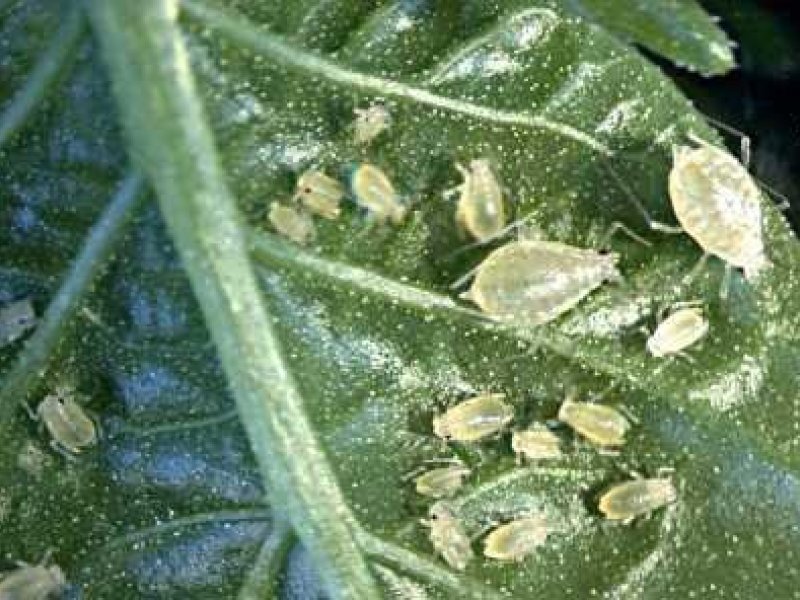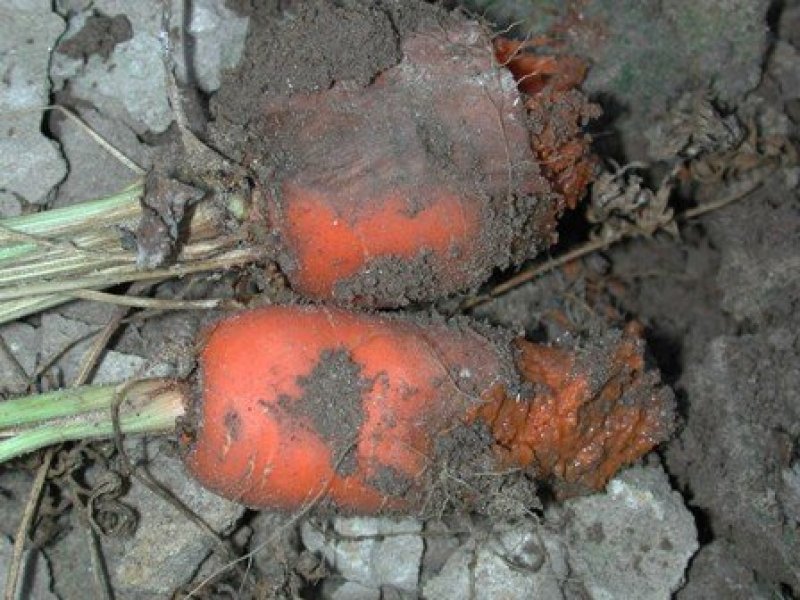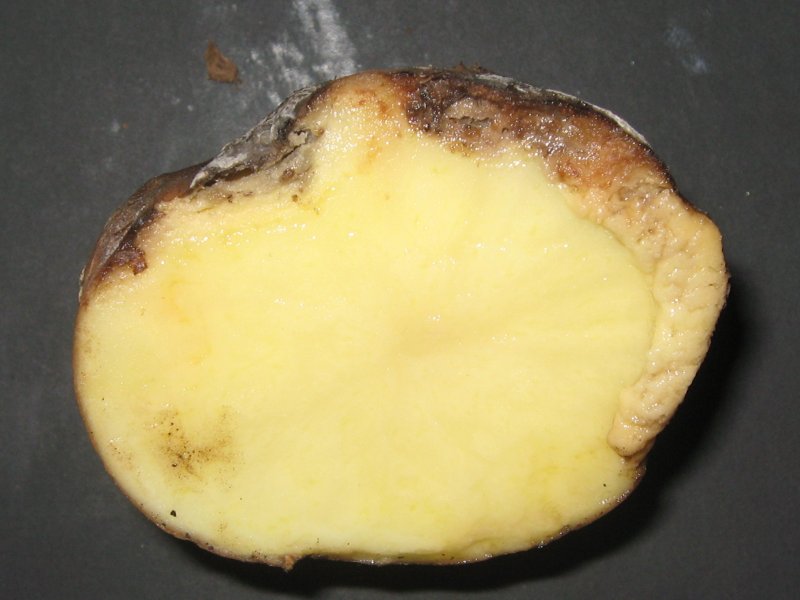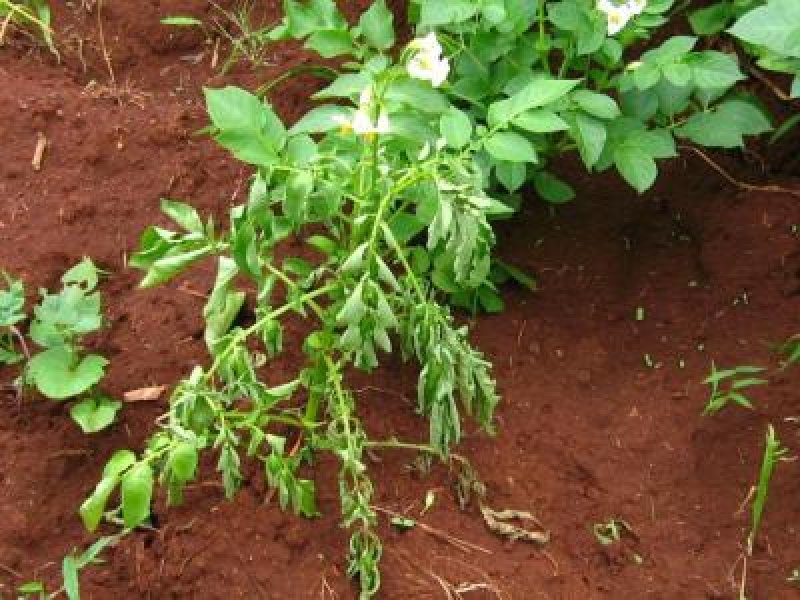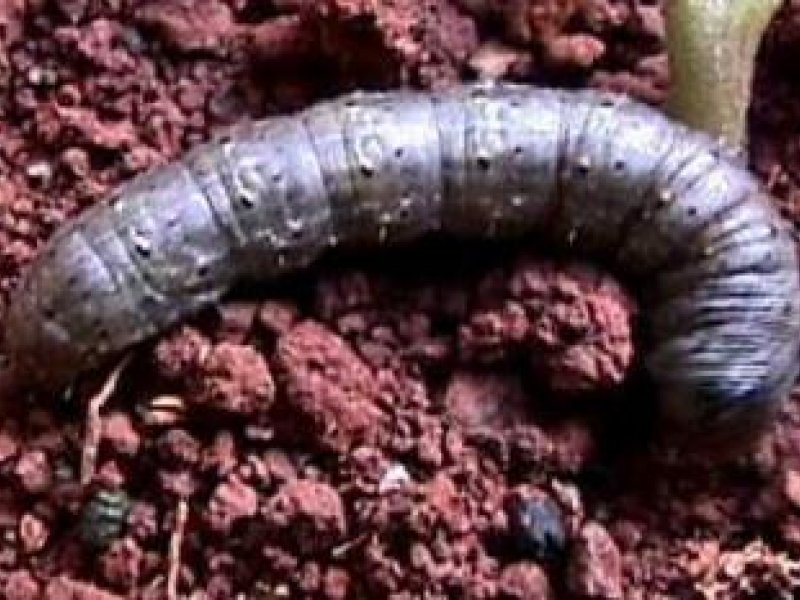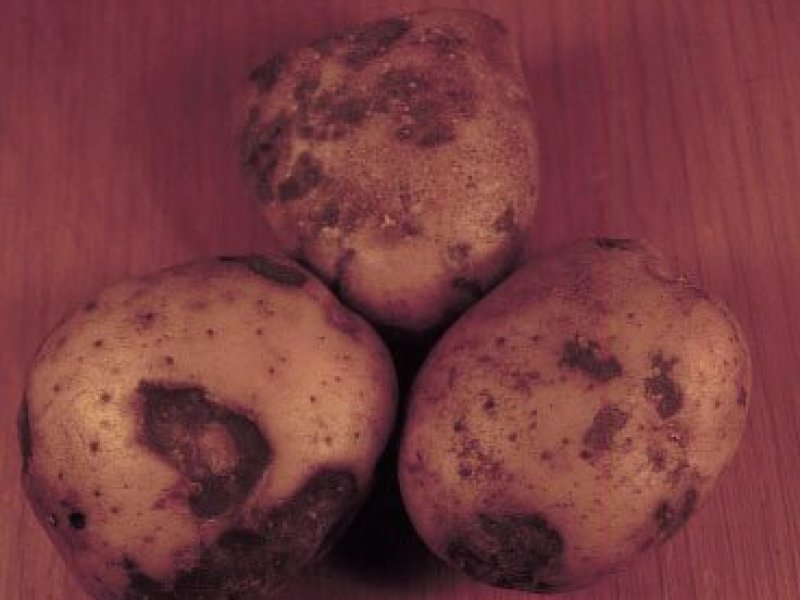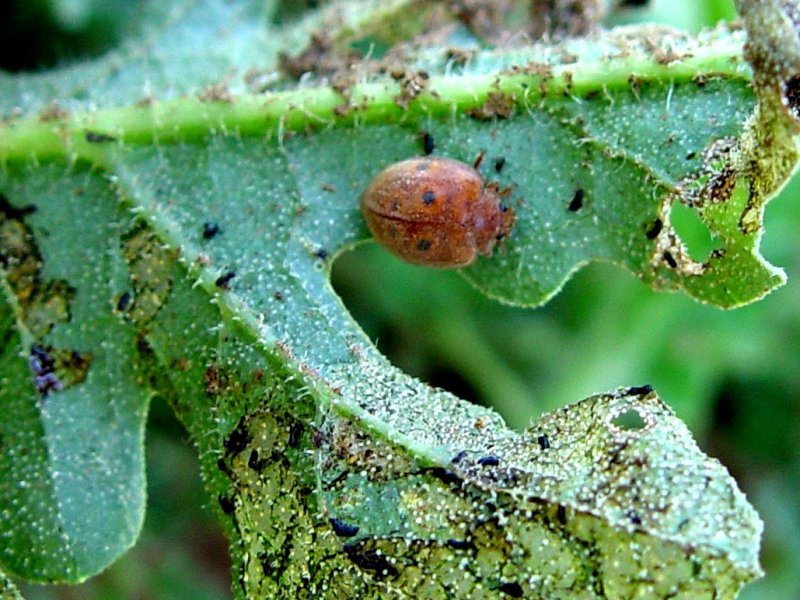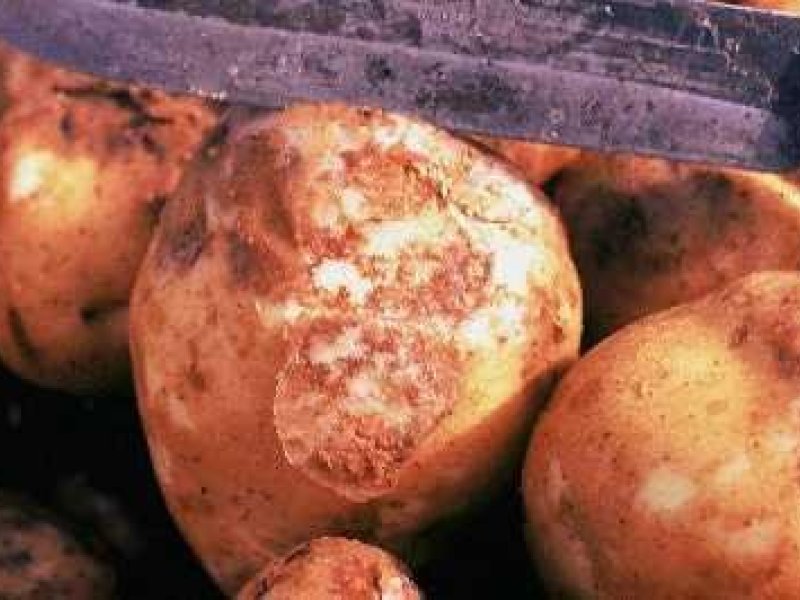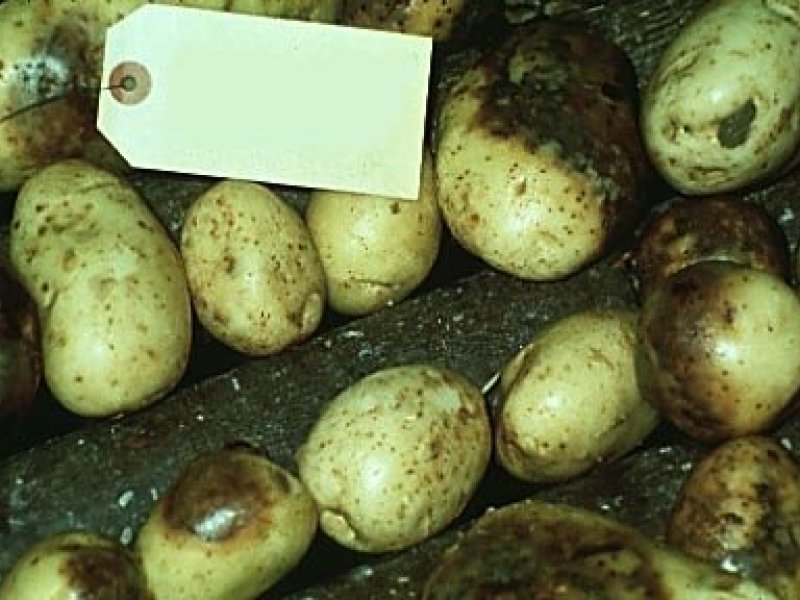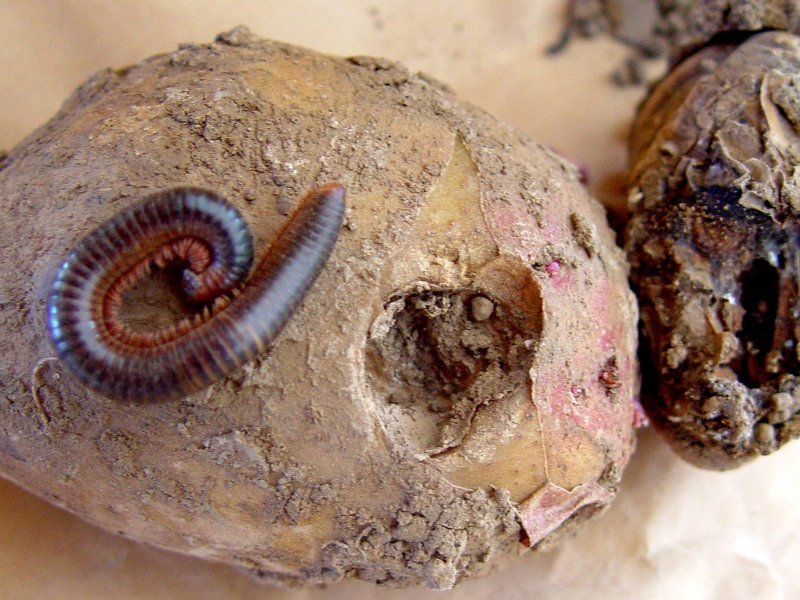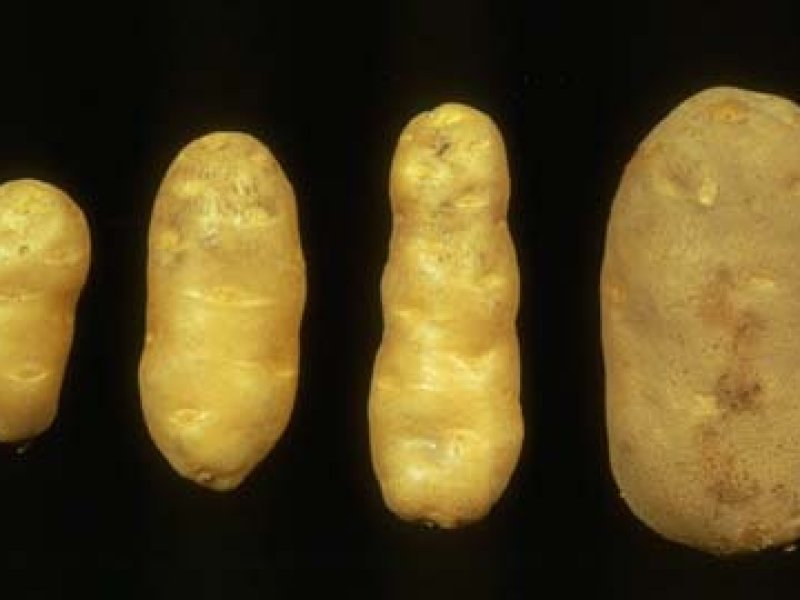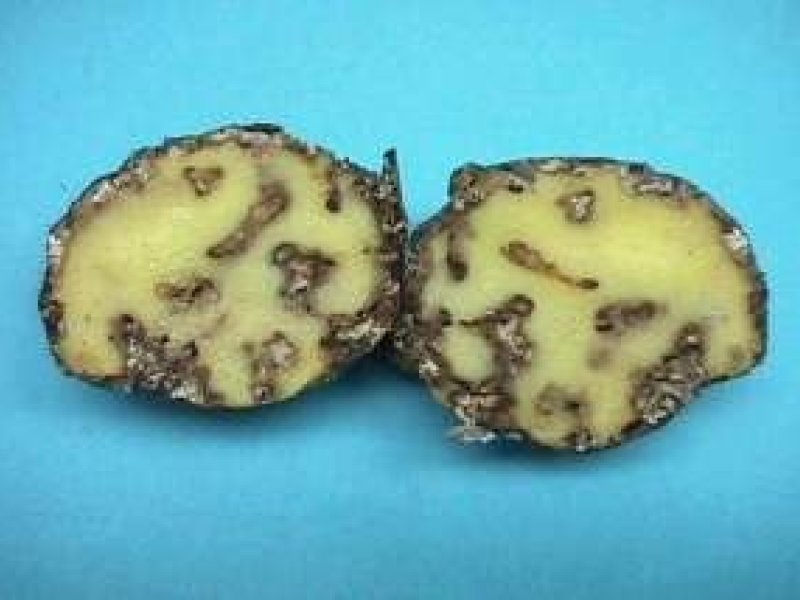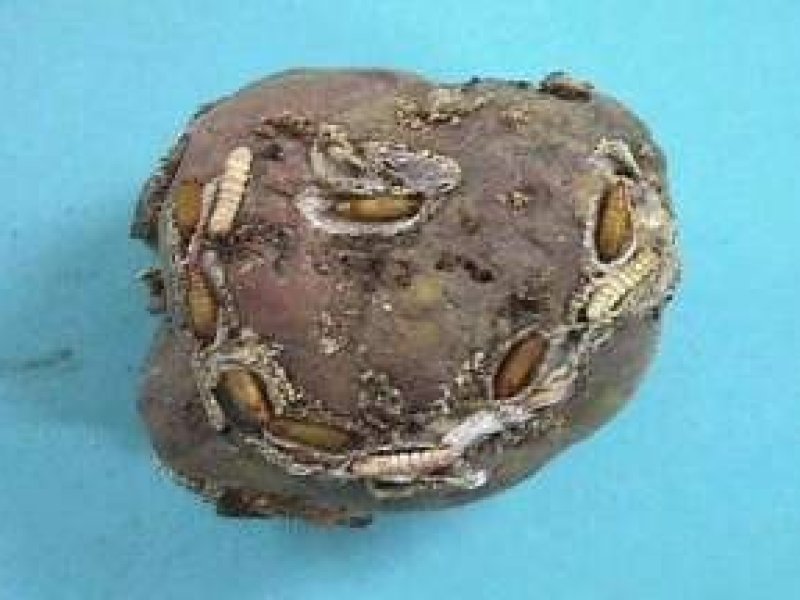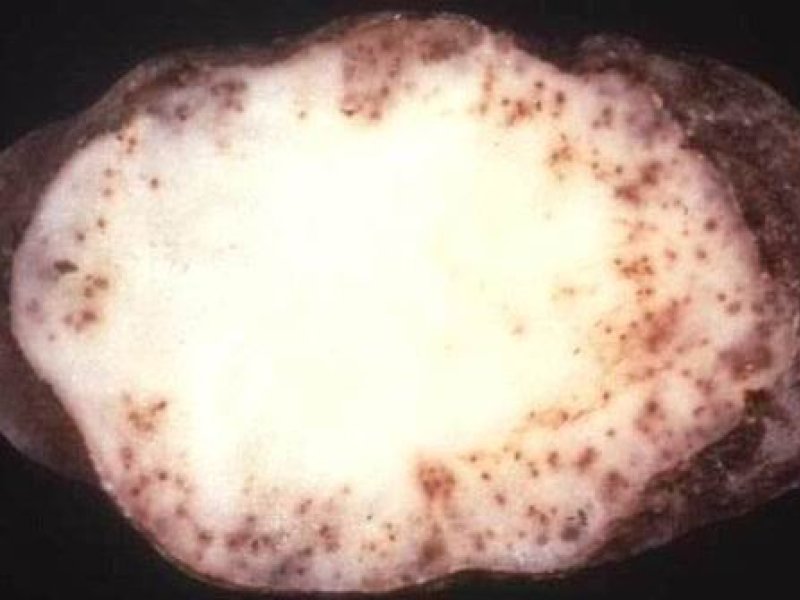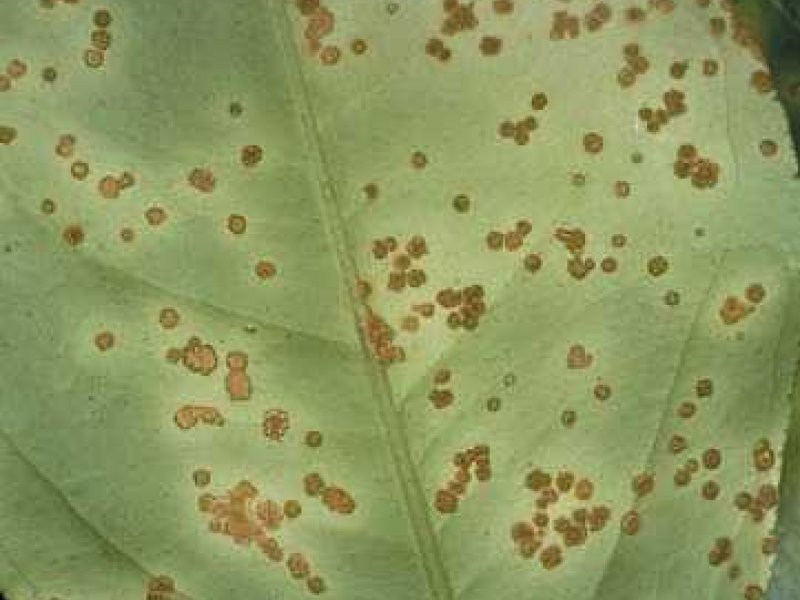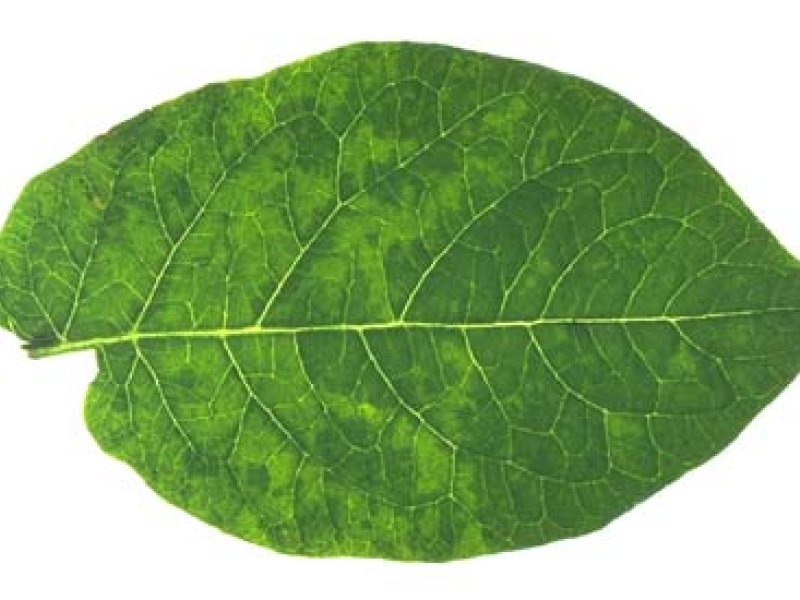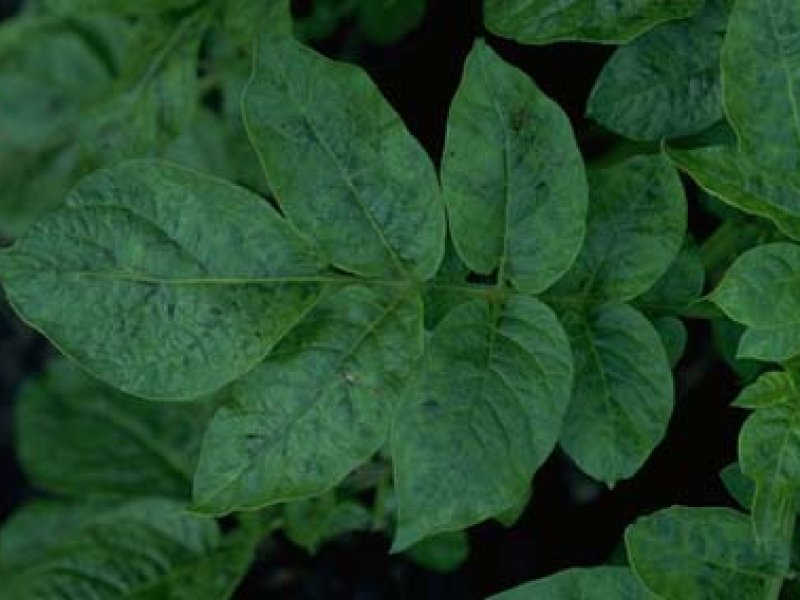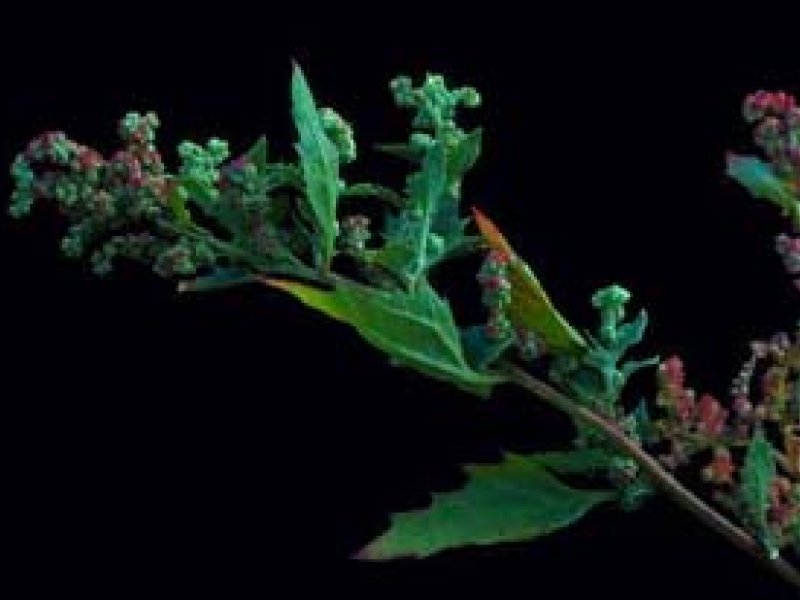|
Aphids (Myzus persicae, Macrosiphum euphorbiae, Aulacorthum solani, Aphis gossypii) Many aphid species attack potatoes. The most important are the green peach aphid (Myzus persicae) the potato aphids (Macrosiphum euphorbiae, Aulacorthum solani) and the cotton aphid (Aphis gossypii). Aphids are mainly found on young shoots on the underside of leaves. Feeding by aphids causes irregular curling of young potato leaflets and hinders growth of the leaflet. Potato aphids can also attack potato sprouts in stores. Direct damage caused by aphids sucking sap from the plant is usually of little importance. Most damage is caused by honeydew production on foliage and virus transmission.
Aphids are important pests as vectors of potato viruses such as the Potato Leaf Roll Virus, a serious disease affecting potatoes. Seed potatoes are particularly susceptible to this virus and even low aphid populations can be very damaging.
|
|
|
What to do:
|
|
Bacterial soft rot (Erwinia carotovora pv. carotovora , E.c. pv. atroseptica) The bacteria enters through wounds and cause extensive rotting of potatoes due to degradation of tuber cell walls, often reducing tubers to a smelly pulp. They may also be carried over on tubers, and shoots (stems) emerging from infected tubers. These are blackened and commonly referred as blackleg, and the affected stems subsequently die.
|
|
|
What to do:
|
|
Bacterial wilt (Ralstonia solanacearum) Bacterial wilt can be very destructive at the lower altitude, warmer extreme of the potato's range in Kenya. This disease causes rapid wilting and death of the entire plant without any yellowing or spotting of leaves. All branches wilt at about the same time. The pathogen is transmitted through tuber seed into the soil. Also infested soil can be important source of disease inoculum (infection).
|
|
|
What to do:
|
|
Cutworms (Agrotis spp) Cutworms are caterpillars of some moths. The caterpillars live in the soil and eat into tubers boring a wide shallow hole. They are also serious pests of newly sprouted potato plants, and can leave empty patches in a potato field.
|
|
|
What to do:
|
|
Early blight (Alternaria solani) Leaf spots of early blight are circular, up to 12 mm in diameter, brown, and often show a circular pattern.
On the potato tuber early blight results in surface lesions that appear a little darker than adjacent healthy skin. Lesions are usually slightly sunken, circular or irregular, brown and vary in size up to 1-2 cm in diameter. There is usually a well defined and sometimes slightly raised margin between healthy and diseased tissue. Internally, the tissue shows a brown to black corky, dry rot, usually not more than 6 mm. Deep cracks may form in older lesions.
Early blight thrives best under warm wet conditions.
|
|
|
What to do:
|
|
Epilachna beetles (Epilachna spp.) Several species of Epilachna beetles feed on the leaf tissue in between the veins leaving a network of veins intact. The adult beetles are oval, about 6 mm in length and reddish brown to brownish yellow in colour with black spots on their backs. They look very similar to the beneficial ladybird beetles (predators), but the body of this pest ladybird beetle is covered with short, light coloured hairs, which give them a non-glossy or matt appearance.
They lay eggs in clusters (20 to 50 eggs), usually on the underside of the leaves and placed vertically. The larvae (grubs) are pale yellow and easily recognisable by the strong branched spines covering their body. Generally, these beetles are minor pests of potatoes, but occasionally the infestation is so severe that control measures are needed.
|
|
|
What to do:
|
|
Late blight (Phytophthora infestans) This disease is favoured by cool, cloudy, wet conditions. Symptoms of late blight are irregular, greenish-black, water soaked patches, which appear on the leaves. The spots soon turn brown and many of the affected leaves wither, yet frequently remain attached to the stem.
|
|
|
What to do:
|
|
Millipedes or thousand-legged worms Millipedes are not insects, but are related to them. They have many legs (30 to 400) with a hard-shelled, round segmented body. They are brown to blackish brown in colour. They move slowly and curl up when disturbed. Millipedes lay eggs singly or in clusters of 20 to 100 in the soil. They live in moist soil and congregate around the plants in soil that is rich in organic content. They dry out easily and die. Thus, they seek wet places, such as compost piles, leaves and other plant debris, to hide under during the day. They tunnel into potato tubers.
|
|
|
What to do:
|
|
Potato cyst nematode G. rostochiensis is indigenous in Peru and is now widely distributed in potato-growing regions. The major hosts of G. rostochiensis are crops in Solanaceae family, potato, tomato, eggplant and solanaceous weeds. PCN are microscopic worms that attack plant roots. The eggs hatch in the soil, juvenile nematodes move to, penetrate and feed on the host roots. After mating, fertilized eggs develop inside females that are attached to roots. When the females die, their skin hardens and becomes a protective brown cover (cyst) around the eggs. Each cyst contains hundreds of eggs, and can remain viable for many years in the absence of host plants. One generation normally occurs during one growing season. At flowering or later stages of the host plant, mature females and cysts can be seen by the naked eye as tiny round objects (about 0.5 mm, the size of a pinhead) on the root surface. Potato cyst nematode is spread by wind, run off water, farm equipment, animals, clothing/foot ware. Symptoms of attack include patches of poor growth, severe stunting, yellowing, wilting and reduced size of potato tubers. |
|
|
What to do:
|
|
Potato Spindle Tuber Viroid (PSTVd) It is particularly destructive for seed production. Potato plants severely infected are upright, stunted and much thinner than normal plants. Leaves of infected plants are smaller and may be grey or distorted. The affected stems are often more branched and branches are at very sharp angles to the stem. Symptoms are more obvious on tubers. Affected tubers are small, narrow and spindle shaped (oblong). In some varieties tubers develop knobs and swellings. In other varieties eyes on tubers are numerous, shallow and prominent, and affected tubers are often cracked. This viroid is easily mechanically transmitted. An infection can be introduced by sowing infected seed tubers, by insects such as aphids, grasshoppers and flea beetles, and through pollen. Tomato and capsicum are additional hosts for PSTVd.
|
|
|
What to do:
|
|
Potato tuber moth (Phthorimaea operculella) This moth is the most serious pest of potatoes in the region. It occurs in Africa wherever potatoes are grown, and it also attacks tobacco, eggplants and tomatoes. The moth is small (measuring about one mm at rest and with 12 to 16 mm wingspan), brownish grey in colour with narrow fringed wings. The moths are active mainly at dusk, but occasionally they can be seen flying within potato plants. Female moths lay eggs singly or in small batches on sheltered places of the foliage (leaf and stems) and near the eye buds on exposed tubers through cracks in the soil or in the store.
The caterpillars are up to 12 mm long and whitish to pale greenish in colour. They feed as leafminers between the upper and the lower epidermis and bore into the petiole, or a young shoot or main leaf vein and later into the tuber. When eggs are laid on tubers, caterpillars begin feeding on the tubers immediately upon hatching. They pupate in a silken cocoon covered with soil particles and debris among dead potato leaves, soil litter, eyes of tubers, and storage walls and floors.
Caterpillars burrowing in the tubers cause major damage by making long irregular black tunnels filled with excreta, where disease-causing microorganisms grow. These tunnels provide an entry point for various plant pathogens and make the potatoes unfit for human consumption. The pest is transferred with the harvested tubers to the potato store, where it can reproduce and infest other tubers. This may lead to total destruction of the stored crop.
|
|
|
What to do:
|
|
Root-knot nematodes (Meloidogyne spp.) Potatoes are very susceptible to root-knot nematodes. Root-knot nematodes prefer warm temperatures and are likely to become established in potato crops grown in relatively warm areas. Generally, they are not a major problem in cool climate potato production areas, but can become a problem when potatoes are grown intensively or rotated with other susceptible crops. Infested potato plants may show varying degrees of stunting, yellowing of leaves and a tendency to wilt under moisture stress. Roots have swellings or galls. Affected tubers have blisters or swellings. On potato tubers, galls may or may not be produced on the tuber surface, depending on cultivars. When galls are produced, they appear as small, raised lumps above giving the skin a rough appearance. Galls may be grouped in a single area or scattered near the tuber eyes. Infestations are difficult to detect in freshly harvested potato tubers. Symptoms may develop when tubers are stored, particularly when taken to warmer climates where nematode numbers can rapidly increase. Symptoms are most severe when crops are grown on sandy soils and warm climates above 25 °C. Nematode attack reduces the quality, size and number of tubers. Root-knot nematode infested potatoes can become more susceptible to bacterial wilt, and symptoms are more severe when plants are also infected with fungal pathogens such as Verticillium and Rhizoctonia. Root-knot nematodes are mainly spread in potato tubers and in infested soil. Egg masses may be transported into clean fields via soil adhering to farm machinery. Spread within fields occurs during cultivation and in water, during irrigation or natural drainage.
|
|
|
What to do:
For more information on Biofumigation click here |
|
Black Scurf and Scab Black scurf (Rhizoctonia solani), powdery scab (Spongospora subterranea) and common scab caused by the bacterium (Streptomyces scabies). These diseases may cause similar symptoms. Black scurf and scab cause skin blemishes (russeting; rough corky tissue) on tubers. These lesions may be so numerous as to involve the entire surface of affected tubers. Such lesions spoil the appearance of the tubers and cause waste in peeling and reduction in grade. These pathogens live in the soil and survive in infected tubers. In most cases infection occurs whilst the tubers are still in the ground. |
|
|
What to do:
|
|
Viral diseases Viral diseases of importance include:
Potato Leaf Roll Virus (PLRV) Potato X Potexvirus (PVX) Potato Virus Y Potyvirus (PVY)
Under field conditions, there is often a composite infection with the 3 viruses (PLRV; PVX; PVY) and it becomes very difficult to distinguish the three on the basis of symptoms. These viruses are transmitted by aphids. PVX causes distinct leaf mottling and crinkling. PVY causes dwarfing of plants, with a rough, mosaic appearance to the leaves and affected plants give a poor crop of small tubers. PVY is also tuber-borne. Potatoes infected with PLRV show an upward and inward rolling of leaflet margins and plants are dwarfed. Affected leaflets become thick and dry, and the lower leaves may become completely brown. Infected plants produce tubers smaller in size and numbers. PLRV also infects other solanaceous crops and weeds (e.g. tomato, tobacco, jimson weed).
|
|
|
What to do:
|
|
Weeds The major weeds in potato crops are annuals. Weeds can reduce yields through direct competition for light, moisture and nutrients. They may harbour pests and diseases that attack potatoes. Early season competition of weeds is very critical. When properly grown, the crop normally covers the ground and smothers any weed competition. Weeds present at harvest increase mechanical damage to the tubers, and reduce harvesting efficiency by slowing down harvesting operations and leaving tubers in the ground. The most important weed in potatoes worldwide is pigweed or fat hen (Chenopodium album). |
|
|
What to do:
|
Geographical Distribution in Africa
Geographical distribution of Potato in Africa. Updated on 8th July 2019. Source FAOSTAT.
General Information and Agronomic Aspects
Potato originated in the highlands of South America, where it has been consumed for more than 8000 years. Spanish explorers brought the plant to Europe in the late 16th century as a botanical curiosity. By the 19th century it had spread throughout the continent, providing cheap and abundant food.
Nearly all of Kenya's potatoes are consumed locally, at an average rate of almost 25 kg per capita a year. Potato is relished by the rural people who grow them and also by higher-income urban dwellers. In Kenya it is considered a high quality and prestigious food item.
Nutritive Value per 100 g of edible Portion
| Raw or Cooked Potato | Food Energy (Calories / %Daily Value*) |
Carbohydrates (g / %DV) |
Fat (g / %DV) |
Protein (g / %DV) |
Calcium (g / %DV) |
Phosphorus (mg / %DV) |
Iron (mg / %DV) |
Potassium (mg / %DV) |
Vitamin A (I.U) |
Vitamin C (I.U) |
Vitamin B 6 (I.U) |
Vitamin B 12 (I.U) |
Thiamine (mg / %DV) |
Riboflavin (mg / %DV) |
Ash (g / %DV) |
| Potato baked (flesh and skin) | 93.0 / 5% | 21.2 / 7% | 0.1 / 0% | 2.5 / 5% | 15.0 / 1% | 70.0 / 7% | 1.1 / 6% | 535.0 / 15% | 10.0 IU / 0% | 9.6 / 16% | 0.3 / 16% | 0.0 / 0% | 0.1 / 4% | 0.0 / 3% | 1.3 |
| Potato cooked in skin (with skin) | 78.0 / 4% | 17.2 / 6% | 0.1 / 0% | 2.9 / 6% | 45.0 / 4% | 54.0 / 5% | 6.1 / 34% | 407 / 12% | 0.0 / 0% | 5.2 / 9% | 0.2 / 12% | 0.0 / 0% | 0.0 / 2% | 0.0 / 2% | 2.0 |
| Red Potato baked (flesh and skin) | 89.0 / 4% | 19.6 / 7% | 0.2 / 0% | 2.3 / 5% | 9.0 / 1% | 72.0 / 7% | 0.7 / 4% | 545 / 16% | 10.0 IU / 0% | 12.6 / 21% | 0.2 / 11% | 0.0 / 0% | 0.1 / 5% | 0.1 / 3% | 1.3 |
*Percent Daily Values (DV) are based on a 2000 calorie diet. Your daily values may be higher or lower, depending on your calorie needs.
Climatic conditions, soil and water management
Potato requires well-distributed rainfall of 500 to 750 mm in a growing period of 3 to 4.5 months. Most commercial cultivars of potato tuberise (form tubers) best in cool climates with night temperatures below 20°C. Optimum day temperatures are within the range of 20 to 25°C. Short day lengths (12 to 13 hours) lead to early maturity. In the short day length conditions of the tropics and subtropics, maximum yields can usually be obtained in cool highland areas and in cooler seasons. Cultivation is concentrated in highland areas from 1200 to 3000 m above sea level.In regions with a critical dry season, planting early in the rainy season is best. If the rainy season is long and excessive, time of planting is usually towards the end of the rainy season.
Potato is tolerant to a rather wide variety of soils, except heavy, waterlogged clays. Good drainage is of great importance. Impermeable layers in the soil limit rooting depth and the amount of available water, and so greatly reduce yields. Deep soils with good water retention and aeration give best growth and yields. The most suitable soil pH is between 4.8 and 6. At higher pH, tubers are liable to suffer from scab disease.
Propagation
Potato is normally propagated vegetatively by small (40 to 100 g) tubers, called 'seed tubers' or 'seed potatoes'. It can also be propagated by pieces of tuber ('seed pieces') or by true seed. The seed rate (tubers) ranges from 1.5 to 4.0 t/ha. The first problem facing growers in developing countries is obtaining supplies of healthy planting material of a suitable cultivar at an acceptable price. Some countries undertake traditional propagation of the seed tubers on sites in the highlands with suitable cool but frost-free climates and where the population of insect vectors of diseases can be kept at an adequately low level.
Recently, the use of true potato seed for propagation has aroused great interest. True seed does not transmit most of the potato diseases, is very light and is easy to transport. Promising methods to grow potatoes from true seed include raising seedlings in a nursery and transplanting them to the field.
Planting
In regions with a critical dry season, planting early in the rainy season is best. If the rainy season is long and excessive, time of planting is usually towards the end of the rainy season. Potato subjected to heavy rainfall during growth or harvest is prone to diseases.
Tubers planted to produce potatoes for consumption should generally be planted in rows 75-100 cm apart with a spacing of 30 to 40 cm within the row (25 to 44,000 plants per ha). The closer spacing should be used in fertile soils and good rainfall areas to avoid the production of very large tubers. Seed potatoes are planted at a spacing of 15 to 20 cm within the row (about 80,000 plants per ha).
Potatoes are planted at a depth of 5 to 15 cm (measured from the top of the tuber). Planting depth is greater under warm, dry conditions than under cool, wet conditions. Shallow plantings should be avoided, because the lower nodes of the stem must remain covered to encourage tuberisation (tuber initiation) and to avoid greening of tubers and tuber moth damage. Earthing up or hilling is carried out to control weeds and to avoid greening of the tubers. Potatoes are normally planted by hand in developing countries, but mechanical planters are available.
Plough-under or incorporate available organic manures in the soil before planting to enhance the water-holding capacity and texture of the soil as well as to provide enough nutrients for a healthy crop. A high yielding potato crop under conventional farming removes 95 to 140 kg N (nitrogen)/ha, 35 kg P (phosphorus)/ha, 125 to 170 kg K (potassium)/ha and has relatively high needs for Mg (magnesium) and Mn (manganese). Organic farmers will need to identify organic sources for similar amounts of nutrients. Potatoes respond well to large amounts of compost or well-rotted animal manures.
Fertiliser recommendations based on soil analysis offer the very best chance of getting the right amount of fertiliser without over or under fertilising. Ask for assistance from the local agriculturist office for soil sampling and soil analysis procedures.
Sources of seed potatoes
In Kenya certified healthy seed potatoes are available from KALRO Tigoni, ADC Molo and Agrico East Africa among others.
Varieties in Kenya and their characteristics
| Variety | Yield | Storage | Drought resistance | Late blight | Viruses | Maturity | Eco-zone |
| "Kenya Baraka" | High | Good | Some resistance | Some resistance | Some resistance | Medium | Medium High |
| "Roslin Eburu" | Medium High | Very good | Resistant | Some resistance | Some resistance | Medium | Medium High |
| "Feldelslohn" | High | Fairly good | Some resistance | Very susceptlible | Some resistance | Medium late | High |
| "Annet" | High | Good | Some resistance | Some resistance | Some resistance | Early | High Medium Low |
| "Dutch Robjn" | High | Very good | Some resistance | Susceptible | Some resistance | Medium | High Medium |
| "Roslin Tana" | High | Fair | Some tolerance | - | - | Medium | High Medium |
| "Roslin Gucha" | Medium | Good | Tolerant | - | - | Medium | High Medium |
| "Desiree" | Medium | Fairly good | Some tolerance | - | - | Medium | High Medium |
| "Roslin Ruaka" | High | Good | Some tolerance | - | - | Medium | High Medium |
| "Cardinal" | Medium | Good | Some tolerance | - | - | Medium | High Medium |
| "Pimpernel" | Medium | Good | Some tolerance | - | - | Medium | High |
| "Arka" | High | Good | Tolerant | - | - | Medium | High Medium |
| "Kerr's Pink" | Medium | Good | Tolerant | - | - | Medium | High Medium |
Note:
High eco-zone = 2300 m altitude
Medium = 1500-2300 m altitude
Low = below 1500 m altitude
High yield = 12-15 tons/ha
Medium yield = 8-10 tons/ha
Low yield = 4-6 tons/ha
(Source: Ministry of Agriculture & Rural Development and Japan International Development Agency (2000)).
Adoption of potato varieties (CIP Nairobi)
Total area harvested in hectares in 2005: 120,842
| Variety Name | Estimated area harvested (%) | Trend in area* | Strengths of variety | Weakness of variety | Main uses of variety |
| "Tigoni" | 30 | Increasing | High yielding, resistant to late blight, big tubers | Sensitive to bacterial wilt | Market |
| "Nyayo" | 25 | Declining | Early maturing, tasty | Sensitive to late blight | Market, home use |
| "Ngure" | 8 | Increasing | High price, early maturing, tasty | Sensitive to late blight | Market and home use |
| "Tana Kimande" | 7 | Increasing | Big tubers, good price | Low yields, late maturing | Market |
| "Asante" | 6 | Increasing | High yielding, resistant to late blight, big tubers | Not good for mashing | Market |
| "Dutch Robijn" | 5 | Increasing | Storage long, crisping | Sensitive to late blight | Market Crisps |
| "Kerr's Pink" | 3 | Declining | High price, early maturing, tasty | Sensitive to late blight | Market, home use |
| "Desiree" | 3 | Constant | Storage long, tasty | Sprout very early | Market |
| "Tigoni Red" | 3 | Increasing | High yielding, resistant to late blight | Sprout very early | Market |
| "Komesha" | 2 | Constant | High yield | Sensitive to bacterial wilt | Market |
| "Meru Mugaruro" | 2 | Increasing | High yield, big tubers | Sensitive to late blight and bacterial wilt | Market |
| "Roslin Tana" | 2 | Declining | Good for chips | Low yields, sensitive to late blight | Market |
| Others | 4 | Increasing | - | - | Home, market |
(Source of estimate: CIP, Nairobi)
Potato varieties released in 2010 by KARI/CIP (AIRC, 2011)
| Variety name | Optimal production altitude (masl) | Duration to maturity (months) | Tuber yield (t/ha) | Special attributes |
| "Purple Gold" | 1800-3000 | 4.0-4.5 | 20 - 35 |
|
| "Kenya Mpya" | 1400-3000 | 3.0-3.5 | 35-45 |
|
| "Sherekea" | 1800-3000 | 3.5-4.0 | 40 - 50 |
|
Husbandry
Adequate control of weeds is required to ensure high yields. In the tropics, manual weeding is generally practised in small-scale production, but herbicides are sometimes used in large-scale production.
Potato responds well to high soil fertility. Manure or compost is needed if the land has been continuously cropped. Well-decomposed animal manure or compost is recommended.
Ridging soon after emergence helps control weeds, prevents greening of developing tubers and prevents spores of late blight fungus from reaching the tubers.
Intercropping
Wide ridges or mounds are required for intercropping. Potatoes can be intercropped with a wide range of annual crops such as sweet potato, maize or even pyrethrum. Potatoes planted in rotation or intercropped with barley, maize, peas, or wheat prevents soil exhaustion. In this case, intercrops are planted at the bottom or at the edge of the furrows and the potatoes on the ridge.
However in order to get full benefit from a potato crop such as high yields, weed suppression and ease of management, without building up high levels of soil-borne diseases: it is recommended to grow potatoes in a separate field and rotate the crop with others. Interplanting with a short season legume such as beans can increase total crop yield and help prevent spread of diseases.
Crop rotation
Avoid planting potatoes in the same field for several consecutive seasons. Proper crop rotation enhances soil fertility, increases soil organic matter, conserves soil moisture and helps maintain soil structure. In addition, it avoids build-up of soil-borne pathogens affecting potato, and reduces the level of soil infestation once the soil has been contaminated. Rotations should not include crops that are common hosts for diseases and pests of potatoes (e.g. tomato, eggplant, pepper). Rice, maize and legumes are recommended for crop rotation practices. Planting brassicas such as broccoli, cabbage and mustard plants before the potato crop helps reducing incidence of bacterial wilt and nematodes. Control volunteer potatoes and weeds in the rotation crop.
Harvesting
Time of harvesting of potato varies with cultivar, cultural practices, climate and price. Tubers harvested while still immature tend to have low dry matter content and to suffer more skin damage, resulting in easier infection by fungal and bacterial pathogens. However, seed potatoes are often harvested early, to avoid virus infection that may occur during the latter part of the growing season. Late blight attack may also be a reason for early harvesting.
The harvesting operation involves destroying the aboveground parts (haulm), lifting and collecting the tubers. A general practice to avoid excess mechanical damage to tubers at harvesting is to cut the tops 10 to 14 days before lifting the potatoes to give them time to develop matured and hardened skins. The haulm is destroyed either by manual or mechanical cutting.
In small-scale farming in the tropics, lifting is done manually using simple implements such as sticks, hoes and spades. Mechanical harvesting is carried out only in large-scale farming areas using various types of potato diggers, for example, ploughs, spinners or elevator diggers. Semi-automatic diggers lift the tubers from the soil for hand-picking or collection. Harvesting should not be done during or immediately after rain.
Yield
In 2014, the average yield of storage potato tubers throughout the world was about 20 tonnes per hectare (t/ha). Average yields (t/ha) for different continents in 2014 were: Asia (18.8), Africa (13.6), North America (43.7), South America (16.5), Europe (22.1) and Oceania (41.3) (FAOSTAT, 2014). In many tropical and subtropical regions potential yields are much higher than actual yields due to constraints (environmental, seasonal, propagation, crop protection, economic and social) that prevent the full expression of this potential, but individual farmers in Kenya have reported yields up to 35 t/ha.
Post harvest handling
Harvesting or any other handling to which potato tubers are subjected may cause damage ranging from external injury to internal bruising. After harvesting it is advantageous to allow the tubers to dry in heaps for about 1 to 2 weeks at 10 to 20°C (or in cold store) under high humidity before further handling. During this time the skin hardens, wounds heal, adhering soil dries and disease symptoms become more visible, which facilitates the removal of the infected tubers. Grading should not be started before the curing and hardening have taken place, otherwise further damage occurs. If the hardening has taken place in the soil before harvesting, grading for sale can be done immediately to avoid greening and sprouting.
Before the tubers go into storage, rotten and infected tubers, which may become sources of post-harvest disease infection, should be removed. Potato tubers are usually delivered into stores in bags, baskets or crates. To facilitate handling, containers should not be too large; if they are large they should not be filled completely. Storage of ware potatoes for the market is associated with undesirable quality changes (mainly sprouting, high sugar content, and weight loss due to evaporation and respiration). For short-term storage (1-2 weeks) in the tropics, ware potatoes may be stored at ambient temperatures in the dark, in well-ventilated buildings. Small-scale farmers can keep potatoes in on-farm storage using inexpensive, well-ventilated constructions.
Storing of seed potatoes
After cold storage, seed potatoes should be pre-sprouted in diffuse light to ensure optimal development of sprouts prior to planting. By storing seed tubers in diffused light at ambient temperatures, excessive sprouting is avoided and seed potatoes can be kept in good physiological condition for a long period of time. If potatoes are stored in bulk without cold storage in the tropics for more than a couple of weeks, they completely loose appeal and will start rotting.
Fresh Quality Specifications for the Market in Kenya
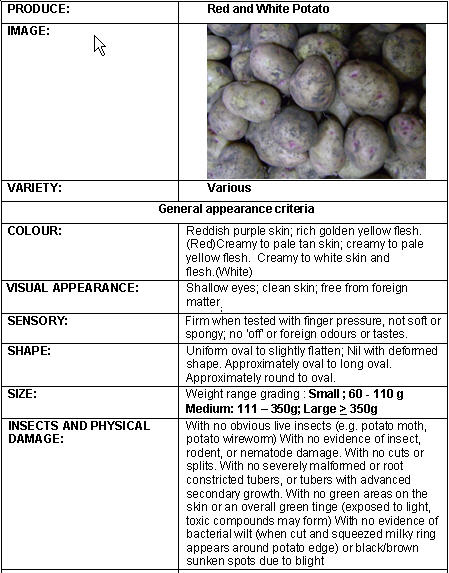 |
| © S. Kahumbu, Kenya |
| Root-knot nematodes (Meloidogyne spp.) Potatoes are very susceptible to root-knot nematodes. Root-knot nematodes prefer warm temperatures and are likely to become established in potato crops grown in relatively warm areas. Generally, they are not a major problem in cool climate potato production areas, but can become a problem when potatoes are grown intensively or rotated with other susceptible crops. Infested potato plants may show varying degrees of stunting, yellowing of leaves and a tendency to wilt under moisture stress. Roots have swellings or galls. Affected tubers have blisters or swellings. On potato tubers, galls may or may not be produced on the tuber surface, depending on cultivars. When galls are produced, they appear as small, raised lumps above giving the skin a rough appearance. Galls may be grouped in a single area or scattered near the tuber eyes. Infestations are difficult to detect in freshly harvested potato tubers. Symptoms may develop when tubers are stored, particularly when taken to warmer climates where nematode numbers can rapidly increase. Symptoms are most severe when crops are grown on sandy soils and warm climates above 25 °C. Nematode attack reduces the quality, size and number of tubers. Root-knot nematode infested potatoes can become more susceptible to bacterial wilt, and symptoms are more severe when plants are also infected with fungal pathogens such as Verticillium and Rhizoctonia. Root-knot nematodes are mainly spread in potato tubers and in infested soil. Egg masses may be transported into clean fields via soil adhering to farm machinery. Spread within fields occurs during cultivation and in water, during irrigation or natural drainage.
What to do:
For more information on Biofumigation click here |
| Aphids (Myzus persicae, Macrosiphum euphorbiae, Aulacorthum solani, Aphis gossypii) Many aphid species attack potatoes. The most important are the green peach aphid (Myzus persicae) the potato aphids (Macrosiphum euphorbiae, Aulacorthum solani) and the cotton aphid (Aphis gossypii). Aphids are mainly found on young shoots on the underside of leaves. Feeding by aphids causes irregular curling of young potato leaflets and hinders growth of the leaflet. Potato aphids can also attack potato sprouts in stores. Direct damage caused by aphids sucking sap from the plant is usually of little importance. Most damage is caused by honeydew production on foliage and virus transmission.
Aphids are important pests as vectors of potato viruses such as the Potato Leaf Roll Virus, a serious disease affecting potatoes. Seed potatoes are particularly susceptible to this virus and even low aphid populations can be very damaging.
What to do:
|
| Cutworms are caterpillars of some moths. The caterpillars live in the soil and eat into tubers boring a wide shallow hole. They are also serious pests of newly sprouted potato plants, and can leave empty patches in a potato field.
What to do:
|
| Epilachna beetles (Epilachna spp.) Several species of Epilachna beetles feed on the leaf tissue in between the veins leaving a network of veins intact. The adult beetles are oval, about 6 mm in length and reddish brown to brownish yellow in colour with black spots on their backs. They look very similar to the beneficial ladybird beetles (predators), but the body of this pest ladybird beetle is covered with short, light coloured hairs, which give them a non-glossy or matt appearance.
They lay eggs in clusters (20 to 50 eggs), usually on the underside of the leaves and placed vertically. The larvae (grubs) are pale yellow and easily recognisable by the strong branched spines covering their body. Generally, these beetles are minor pests of potatoes, but occasionally the infestation is so severe that control measures are needed.
What to do:
|
| Millipedes or thousand-legged worms Millipedes are not insects, but are related to them. They have many legs (30 to 400) with a hard-shelled, round segmented body. They are brown to blackish brown in colour. They move slowly and curl up when disturbed. Millipedes lay eggs singly or in clusters of 20 to 100 in the soil. They live in moist soil and congregate around the plants in soil that is rich in organic content. They dry out easily and die. Thus, they seek wet places, such as compost piles, leaves and other plant debris, to hide under during the day. They tunnel into potato tubers.
What to do:
|
| G. rostochiensis is indigenous in Peru and is now widely distributed in potato-growing regions. The major hosts of G. rostochiensis are crops in Solanaceae family, potato, tomato, eggplant and solanaceous weeds. PCN are microscopic worms that attack plant roots. The eggs hatch in the soil, juvenile nematodes move to, penetrate and feed on the host roots. After mating, fertilized eggs develop inside females that are attached to roots. When the females die, their skin hardens and becomes a protective brown cover (cyst) around the eggs. Each cyst contains hundreds of eggs, and can remain viable for many years in the absence of host plants. One generation normally occurs during one growing season. At flowering or later stages of the host plant, mature females and cysts can be seen by the naked eye as tiny round objects (about 0.5 mm, the size of a pinhead) on the root surface. Potato cyst nematode is spread by wind, run off water, farm equipment, animals, clothing/foot ware. Symptoms of attack include patches of poor growth, severe stunting, yellowing, wilting and reduced size of potato tubers. What to do:
|
| Potato tuber moth (Phthorimaea operculella) This moth is the most serious pest of potatoes in the region. It occurs in Africa wherever potatoes are grown, and it also attacks tobacco, eggplants and tomatoes. The moth is small (measuring about one mm at rest and with 12 to 16 mm wingspan), brownish grey in colour with narrow fringed wings. The moths are active mainly at dusk, but occasionally they can be seen flying within potato plants. Female moths lay eggs singly or in small batches on sheltered places of the foliage (leaf and stems) and near the eye buds on exposed tubers through cracks in the soil or in the store.
The caterpillars are up to 12 mm long and whitish to pale greenish in colour. They feed as leafminers between the upper and the lower epidermis and bore into the petiole, or a young shoot or main leaf vein and later into the tuber. When eggs are laid on tubers, caterpillars begin feeding on the tubers immediately upon hatching. They pupate in a silken cocoon covered with soil particles and debris among dead potato leaves, soil litter, eyes of tubers, and storage walls and floors.
Caterpillars burrowing in the tubers cause major damage by making long irregular black tunnels filled with excreta, where disease-causing microorganisms grow. These tunnels provide an entry point for various plant pathogens and make the potatoes unfit for human consumption. The pest is transferred with the harvested tubers to the potato store, where it can reproduce and infest other tubers. This may lead to total destruction of the stored crop.
What to do:
|
| Bacterial wilt (Ralstonia solanacearum) Bacterial wilt can be very destructive at the lower altitude, warmer extreme of the potato's range in Kenya. This disease causes rapid wilting and death of the entire plant without any yellowing or spotting of leaves. All branches wilt at about the same time. The pathogen is transmitted through tuber seed into the soil. Also infested soil can be important source of disease inoculum (infection).
What to do:
|
| Bacterial soft rot (Erwinia carotovora pv. carotovora , E.c. pv. atroseptica) The bacteria enters through wounds and cause extensive rotting of potatoes due to degradation of tuber cell walls, often reducing tubers to a smelly pulp. They may also be carried over on tubers, and shoots (stems) emerging from infected tubers. These are blackened and commonly referred as blackleg, and the affected stems subsequently die.
What to do:
|
| Late blight (Phytophthora infestans) This disease is favoured by cool, cloudy, wet conditions. Symptoms of late blight are irregular, greenish-black, water soaked patches, which appear on the leaves. The spots soon turn brown and many of the affected leaves wither, yet frequently remain attached to the stem.
What to do:
|
| Early blight (Alternaria solani) Leaf spots of early blight are circular, up to 12 mm in diameter, brown, and often show a circular pattern.
On the potato tuber early blight results in surface lesions that appear a little darker than adjacent healthy skin. Lesions are usually slightly sunken, circular or irregular, brown and vary in size up to 1-2 cm in diameter. There is usually a well defined and sometimes slightly raised margin between healthy and diseased tissue. Internally, the tissue shows a brown to black corky, dry rot, usually not more than 6 mm. Deep cracks may form in older lesions.
Early blight thrives best under warm wet conditions.
What to do:
|
| Black scurf (Rhizoctonia solani), powdery scab (Spongospora subterranea) and common scab caused by the bacterium (Streptomyces scabies). These diseases may cause similar symptoms. Black scurf and scab cause skin blemishes (russeting; rough corky tissue) on tubers. These lesions may be so numerous as to involve the entire surface of affected tubers. Such lesions spoil the appearance of the tubers and cause waste in peeling and reduction in grade. These pathogens live in the soil and survive in infected tubers. In most cases infection occurs whilst the tubers are still in the ground. What to do:
|
| Viral diseases of importance include:
Potato Leaf Roll Virus (PLRV) Potato X Potexvirus (PVX) Potato Virus Y Potyvirus (PVY)
Under field conditions, there is often a composite infection with the 3 viruses (PLRV; PVX; PVY) and it becomes very difficult to distinguish the three on the basis of symptoms. These viruses are transmitted by aphids. PVX causes distinct leaf mottling and crinkling. PVY causes dwarfing of plants, with a rough, mosaic appearance to the leaves and affected plants give a poor crop of small tubers. PVY is also tuber-borne. Potatoes infected with PLRV show an upward and inward rolling of leaflet margins and plants are dwarfed. Affected leaflets become thick and dry, and the lower leaves may become completely brown. Infected plants produce tubers smaller in size and numbers. PLRV also infects other solanaceous crops and weeds (e.g. tomato, tobacco, jimson weed).
What to do:
|
| Potato Spindle Tuber Viroid (PSTVd) It is particularly destructive for seed production. Potato plants severely infected are upright, stunted and much thinner than normal plants. Leaves of infected plants are smaller and may be grey or distorted. The affected stems are often more branched and branches are at very sharp angles to the stem. Symptoms are more obvious on tubers. Affected tubers are small, narrow and spindle shaped (oblong). In some varieties tubers develop knobs and swellings. In other varieties eyes on tubers are numerous, shallow and prominent, and affected tubers are often cracked. This viroid is easily mechanically transmitted. An infection can be introduced by sowing infected seed tubers, by insects such as aphids, grasshoppers and flea beetles, and through pollen. Tomato and capsicum are additional hosts for PSTVd.
What to do:
|
Information Source Links
- Acland, J.D. (1980). East African Crops. FAO / Longman. ISBN: 0 582 60301 3
- Agricultural Information Resource Centre (2011). Agricultural Information Directory 2011/2012. Nairobi, Kenya. ISBN: 9966 764 08 9
- Ali, M.A (1993). Effects of cultural practices on reducing field infestation of potato tuber moth (Phthorimaea operculella) and greening of tubers in Sudan. Journal of Agricultural Science, 121(2): 187-192; 19 ref.
- Berg, G. (2006). Agriculture notes. Root-knot nematode on potatoes. AG0574. ISSN 1329-8062. State of Victoria, Department of Primary Industries.
- Bohlen, E. (1973). Crop pests in Tanzania and their control. Federal Agency for Economic Cooperation (bfe). Verlag Paul Parey. ISBN: 3-489-64826-9.
- CAB International (2005). Crop Protection Compendium, 2005 Edition. Wallingford, UK www.cabi.org
- CIP Nairobi (2005). Estimates of Currently grown potato cultivars.
- Centipedes and millipedes. Later's Pest Info Bulletin.
- Department for Environment, Food and Rural Affairs (DEFRA) (2002). Meloidogyne chitwoodi (the Columbia root-knot nematode) and Meloidogyne fallax www.defra.gov.uk
- Godfrey,L. D., Davis, U.C., Haviland, D. R.(2003). UC Pest Management Guidelines. How to Manage Pests. Potato Aphids, green peach aphid (Myzus persicae), potato aphid (Macrosiphum euphorbiae)]. UC IPM Pest Management Guidelines: Potato. UC ANR Publication 3463. Insects. UC Cooperative Extension, Kern Co. (Reviewed 6/03, updated 6/03). Statewide IPM Program, Agriculture and Natural Resources, University of California.
- Karren, J. B. Millipedes. Fact sheet No. 21. Revised April 2000. extension.usu.edu
- Kfir, R. (2003). Biological control of the potato tuber moth Phthorimaea opercullela in Africa. In: Neuenschwander, P. - Biological Control in IPM Systems in Africa.
- Kroschel, J. (1995). Integrated pest management in potato production in the Republic of Yemen- with special reference to the integrated biological control of the potato tuber moth (Phthorimaea operculella Zeller). Tropical Agriculture 8.GTZ. Margraf Verlag. ISBN: 3-8236-1242-5.
- Ministry of Agriculture and Rural Development (Kenya) & Japan International Cooperation Agency (2000). Local and Export Vegetables Growing Manual. Reprinted by Agricultural Information Resource Centre, Nairobi, Kenya. 274 pp.
- National Potato Catalogue, 2017. www.npck.org. Accessed on 18th December 2018
- Nutrition Data www.nutritiondata.com.
- Oisat. Organisation for Non-Chemical Pest Management in the Tropics. www.oisat.org
- Ostermann, H. and Dreyer, M. (1995). Neem Products for Pest management. Vegetables and grain legumes. In: The Neem tree Azadirachta indica A. Juss. and other meliaceous plants sources of unique natural products for integrated pest management, industry and other purposes. Edited by H. Schmutterer in collaboration with K. R. S. Ascher, M. B. Isman, M. Jacobson, C. M. Ketkar, W. Kraus, H. Rembolt, and R.C. Saxena. VCH. pp. 392-403. ISBN: 3-527-30054-6.
- Potatoes. Kenya Overview research.cip.cgiar.org
- Saxena, R. C. (1995). Neem Products for Pest management. Pest of stored products. In: The Neem tree Azadirachta indica A. Juss. and other meliaceous plants sources of unique natural products for integrated pest management
- Zebitz, C. P. W. (1995). Neem Products for Pest management. Root and Tuber Crops. In "The Neem tree Azadirachta indica A. Juss. and other meliaceous plants sources of unique natural products for integrated pest management, industry and other purposes". (1995). Edited by H. Schmutterer in collaboration with K. R. S. Ascher, M. B. Isman, M. Jacobson, C. M. Ketkar, W. Kraus, H. Rembolt, and R.C. Saxena. VCH. pp. 403-407. ISBN: 3-527-30054-6.
- Zitter, T.A., Gallenberg, D.J. (2002). Virus and viroid diseases of potato. Department of Plant Pathology, Cornell University. www.vegetablemdonline.ppath.cornell.edu
Contact Information
- Corner Shop, Nairobi cls@mitsuminet.com
- Food Network East Africa Ltd info@organic.co.ke Tel. +254 0721 100 001
- Green Dreams admin@organic.co.ke Tel. +254 0721 100 001
- Kalimoni Greens kalimonigreens@gmail,com Tel +254 0722 509 829
- Karen Provision Stores karenstoresltd@yahoo.com Tel. 020885552
- Muthaiga Green Grocers, Nairobi
- Uchumi Supermarket
- Zuchinni Green Grocers , Nairobi Tel. 0204448240

